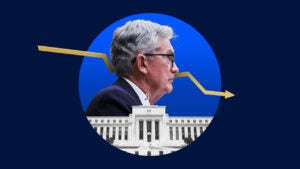Fed hikes interest rates by 0.75 percentage point for fourth straight meeting

The Federal Reserve on Wednesday cracked down on the hottest price surge in four decades with a fourth massive rate hike worth three-quarters of a percentage point and signaled plans to take interest rates even higher than previously expected — though the path to get there may eventually include smaller increases.
Rate-setters on the Federal Open Market Committee (FOMC) adjusted their key benchmark borrowing rate to a new target range of 3.75-4 percent, the highest since early 2008 and the sixth straight increase officials have approved this year.
Not since the early 1980s has the Fed been so aggressive about deliberately slowing the economy, a decade when officials took interest rates from 14 percent to a record-breaking near 20 percent. They were chasing inflation, which had also surged to the highest level on record.
Higher interest rates are what the Fed is hoping will cure inflation’s bite on the economy — though that medicine has yet to take effect. Consumer inflation in September rose 8.2 percent from a year ago, down only slightly from June’s high of 9.1 percent. Meanwhile, inflation is broadening out beyond expensive food and gasoline prices to impact rent, medical care and services, a troubling sign for Fed officials who fear it might suggest price pressures could linger for longer.
Federal Reserve Chair Jerome Powell said the latest data on price pressures suggested to him that interest rates might need to rise higher than the peak target range of 4.5-4.75 percent that officials projected in September.
“It’s very premature in my view to think about or be talking about pausing our rate hikes,” Powell told reporters at a post-meeting press conference. “We still have some ways to go, and incoming data since our last meeting suggests that the ultimate level of interest rates will be higher than previously expected.”
The Fed’s latest move matters for consumers because it could weigh even more on their ability to finance big-ticket purchases, from cars to homes. Some of the prices Americans pay to borrow money have already surged to a 20-year high, and those affordability challenges can be expected to continue as the Fed stays hawkish. Savers, however, are finding the best returns in more than a decade if they shop around.
Experts say the ripple effects of higher interest rates can take more than a year to fully filter through the economy, and the Fed only just got started with raising interest rates eight months ago. Policymakers, however, have suggested they might not want to keep raising interest rates at this speed.
In a first possible acknowledgement of an upcoming slowdown, policymakers indicated in their post-meeting statement that ongoing increases would still be appropriate, but officials would take those lags into consideration, as well as “the cumulative tightening of monetary policy.”
“The interest rate mantra for 2023 is shaping up as ‘higher for longer,’” says Greg McBride, CFA, Bankrate chief financial analyst. “Unfortunately, we’re likely to feel the pain of a slower economy before we see the gain of lower inflation.”
The Fed’s rate hike: What it means for you
Mortgages and refinance rates
To see higher rates in motion, look no further than the price of financing a home.
At the start of the year, a monthly payment on a $300,000 mortgage with a 3.4 percent annual percentage rate (APR) would’ve cost you $1,330 in principal and interest, according to Bankrate’s mortgage calculator. Today, with the average mortgage rate hitting 7.12 percent in the week that ended on Oct. 26, it’d cost you $2,020 — a 52 percent jump.
The Fed’s massive rate increases this year have pushed the average rate on a 30-year fixed-rate mortgage to levels not seen since 2002, while rates on home equity lines of credit haven’t been this high in 14 years, according to McBride.
Mortgage rates more closely follow the 10-year Treasury yield than the Fed, though both are influenced by the same forces. That key benchmark hit 4.1 percent at the end of October, the highest since 2007, no doubt contributing to the pick up in mortgage rates last month. But that also means mortgage rates don’t have to wait on the Fed to peak.
The uncertain future underscores an important point for would-be homebuyers: Keep an eye on interest rates and compare offers from multiple lenders to ensure you find the best deal.
Borrowers
Paying down high-cost credit card debt and refinancing any variable-rate debts into fixed loans are the two most important steps you can take right now if you have debt in a rising-rate environment. Doing so could help limit your exposure to high interest rates, potentially shaving hundreds of dollars off of your monthly interest payments.
Consumers with credit card debt can find balance-transfer cards on the market with 0 percent introductory annual percentage rates (APRs) lasting for 12 to 21 months. To see if it’s the right move for you, calculate the cost of transferring over your debt — which usually comes with a fixed fee — and see if you’d end up saving money in the long run.
Savers
Higher interest rates impact everyone differently depending on their financial situation — and savers with minimal variable-rate, high-cost debts are likely reaping the biggest benefits from the Fed’s aggressive rate moves.
Banks have had no choice but to pay consumers more for the money they keep in accounts there as the Fed lifts rates. Even though traditional brick-and-mortar banks have more than doubled their yields over the past year, from 0.06 percent to an average yield of 0.16 percent today, online banks are offering even better payouts. The banks featured in Bankrate’s best high-yield savings accounts list for November are offering an average yield of 2.5 percent. Some, meanwhile, are even offering up to 3 percent — almost 19 times the national average.
All of that could translate to big earnings. If you were to keep a $10,000 deposit in a bank with a 2.5 percent yield for a year, you’d earn $253 versus $16 at the average bank.
Still, inflation is eating away at the money consumers keep on the sidelines, meaning savers aren’t entirely getting ahead. Yet, building up a substantial cushion of cash consumers can use in emergencies has long been the key point of stashing cash away.
Don’t let the thought of technically losing purchasing power keep you from building up your emergency fund, especially now with higher interest rates increasing the odds of a recession.
Investors
The fastest rate hikes in 40 years have no doubt made 2022 a wild year for investors. The S&P 500 is down about 20 percent so far this year, as market participants process stubbornly high inflation and the potential harm to the economy brought on by an aggressive Fed.
But if you are invested for the long haul and maintain a diversified portfolio, bumpy rides in the stock market are to be expected and not something to get overly concerned about. Keep in mind that the best time to invest is often when the stock market looks its riskiest.
Markets are also forward-looking. When the Fed does eventually slow down how much its hiking interest rates, investors could cheer the news — even if the financial system around them looks bleak.
The opposite has also been true, with the key stock index sinking 17 percent between mid-August and mid-October, even as employers kept adding nearly half a million jobs to the economy and consumption held up despite rampant inflation.
The Fed’s rate path: How much higher will rates go?
Policymakers have long said they won’t be raising interest rates forever. Previous projections from September suggested the Fed might be interested in hiking borrowing costs by a slower 50 basis points as soon as December.
During the press conference, however, Powell added “no decision has been made” on when that slowdown could occur, adding it might happen as soon as the Fed’s December meeting or the gathering after it in January 2023. Yet, he also acknowledged that the rush to push rates higher isn’t as strong today as it was when they were hiking from rock-bottom.
September’s rate hike took interest rates to a level seen as officially starting to take steam away from the economy, and November’s increase took them further into that territory.
“At some point, it will become appropriate to slow the pace of increases,” Powell said. “The question of when to moderate the pace of increases is now much less important than the question of how high to raise rates and how long to keep monetary policy restrictive, which really will be our principal focus.”
It highlights how finding the right time to pull back on tightening is just part of the concern. Officials added in their post-meeting statement that borrowing costs will likely have to hold at a level that’s restrictive for some time — meaning a pause is nowhere near being on the Fed’s radar.
“We have some ground to cover with interest rates before we get to that level of interest rates that we think is sufficiently restrictive,” Powell said. “I would want people to understand our commitment to getting this done.”
Overheated job market indicates Fed’s need to slow economy further
Powell described an “overheated” job market as a factor that’s telling them they need to do more to slow down the economy.
By most measures, the job market remains tight, and workers appear to have no problem finding a new position, even if they’ve been let go. Layoffs fell in September, while job openings picked up in the month. The number of Americans applying for new unemployment benefits has risen by about 31 percent since the Fed’s first rate hike in March, yet continuing applications for those benefits are down 38 percent from a year ago, according to the Department of Labor.
The ratio of jobless workers to vacant positions — one of Fed Chair Jerome Powell’s favorite gauges to judge whether there are still mismatches in labor supply and labor demand — is barely below 2-to-1.
Some softening in the labor market is what Powell and Co. are looking for to take the edge off of inflation — though it’s taking time to show up despite 3.75 percentage points of tightening so far this year.
The higher rates climb and the longer they hold at that restrictive level, the more challenging the job market could become. A Bankrate survey of economists showed joblessness hitting 4.4 percent by October 2023, matching Fed projections from September.
“What we’re waiting on is essentially the passage of time,” says Matt Stucky, senior portfolio manager at Northwestern Mutual Wealth Management. “You can’t say we’re going to pivot right now while looking at backward-looking measures of inflation. You clearly don’t have room to do that yet.”
On the one hand, the Fed doesn’t want to risk pulling away too soon, which could keep high inflation entrenched. At the same time, however, the Fed doesn’t want to overtighten.
Powell admitted the path to getting the timing right — achieving a so-called “soft-landing” of the economy — has narrowed, especially as policy needs to be more than previously thought to tame inflation.
“Upcoming meetings will bring smaller rate hikes but a higher eventual stopping point and for a longer period once we get there,” McBride says. “The lagged effect of all these interest rate hikes means a rapidly slowing economy in 2023. The abrupt slowdown in the housing market is a harbinger of broader economic slowing to come.”
Why we ask for feedback Your feedback helps us improve our content and services. It takes less than a minute to complete.
Your responses are anonymous and will only be used for improving our website.






